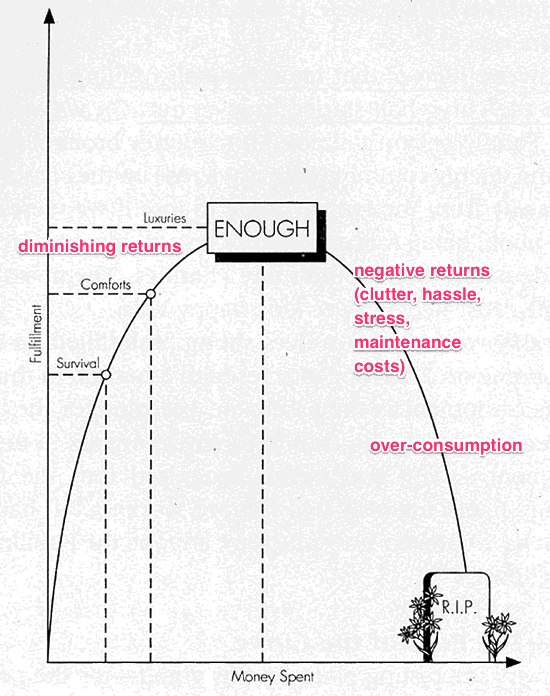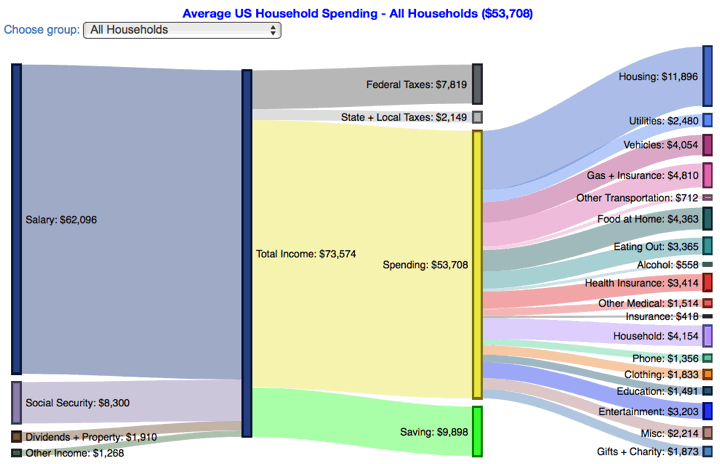Our youngest child successfully completed her first semi-autonomous Halloween, but also threw up after eating her candy. Instead of just a case of diminishing returns (stops tasting as good), it was an important life lesson about negative returns! This reminded me of the “Enough Curve” from the early retirement manifesto Your Money or Your Life, which maps the relationship between fulfillment and the money spent.

In the beginning, you are getting a lot of “bang for your buck”. You have the basics: enough to eat, safe shelter, clothing and general safety. After that, you are moving into comforts that help you think beyond day-to-day survival. This is a good thing. However, eventually you start getting diminishing returns where an extra dollar spent isn’t getting you much more in personal fulfillment.
If you keep going, as the TV ads say you “deserve”, you can get to a point where you experience negative returns. You spend more, but get less. Minimalists call this when “Your stuff owns you” vs. You owning your stuff. Here’s a few examples:
Too much housing. The more house you buy, the higher the insurance costs, lawn maintenance costs, home repair costs, heating/cooling/electricity/gas/utilities costs, cleaning costs, security costs, and so on. If you have too much space, you may also find yourself filling the extra space with junk you don’t even need. Extra furniture, extra toys, who knows.
Too much car. The more car you buy, the higher the insurance costs, repair costs, maintenance costs, detailing costs, and so on. You worry more about small scratches and dings. The strange thing is that the most expensive cars are not any more reliable or long-lasting than a Toyota Corolla or Prius.
Housing, cars, utilities, gas, and insurance costs are linked together and add up to nearly half of all household spending as shown in this visualization from Engaging Data :

Housing and car purchases tend to be infrequent, so the next time it comes up, try to take a good hard look at the total cost. One of the central tenets of Your Money or Your Life is that you are exchanging your finite life energy for money. Once you internalize that, you realize that many things are not worth exchanging years of your life working.
I’m not here to draw a line about what is okay and what isn’t, as it will be different for every person and every expense. I struggle with this as well. This is just a reminder that it’s easy to minimize this extra financial and mental baggage when the dopamine rush comes at the time of purchase. Finding enough is hard, but taking a moment to consider the ongoing costs helps me make better decisions.
 The Best Credit Card Bonus Offers – 2025
The Best Credit Card Bonus Offers – 2025 Big List of Free Stocks from Brokerage Apps
Big List of Free Stocks from Brokerage Apps Best Interest Rates on Cash - 2025
Best Interest Rates on Cash - 2025 Free Credit Scores x 3 + Free Credit Monitoring
Free Credit Scores x 3 + Free Credit Monitoring Best No Fee 0% APR Balance Transfer Offers
Best No Fee 0% APR Balance Transfer Offers Little-Known Cellular Data Plans That Can Save Big Money
Little-Known Cellular Data Plans That Can Save Big Money How To Haggle Your Cable or Direct TV Bill
How To Haggle Your Cable or Direct TV Bill Big List of Free Consumer Data Reports (Credit, Rent, Work)
Big List of Free Consumer Data Reports (Credit, Rent, Work)
I love this. We just upsized dramatically from a 1200 sf house to a 3000+, multi-story century home. (We didn’t necessarily want such a big house, it’s just what’s available in the neighborhood we wanted.) The yard work is insane and I’ve had to stop myself from buying marginally useful things just because we have the space. The most recent near-purchase was a thrift store cake carrier, which I figured I would use once a year at most. But we suddenly have so much kitchen cabinet space that it would live in its own drawer the other 364 days, and at only $2 there seemed like very little downside. I put it back when I realized that it’s never just one purchase and lots of little $2 items here and there add up to a lot of wasted cash and clutter. It’s going to require constant vigilance not to fill up the house.
Cara, curious as to what a “century home” is?
YMOYL really helped me distinguish wants verus needs.
Luckily, I was introduced to YMOYL before I finished college and began living below my means from my first ‘real job’ paycheck. This has allowed me a lot of flexibility and choice, which I value. It wasn’t easy building up an emergency fund when so many comforts and luxuries were competing for my disposable income. I moved recently with the help of professional movers. All the moving cost estimates I obtained were ‘below average’ because I owned less than average.